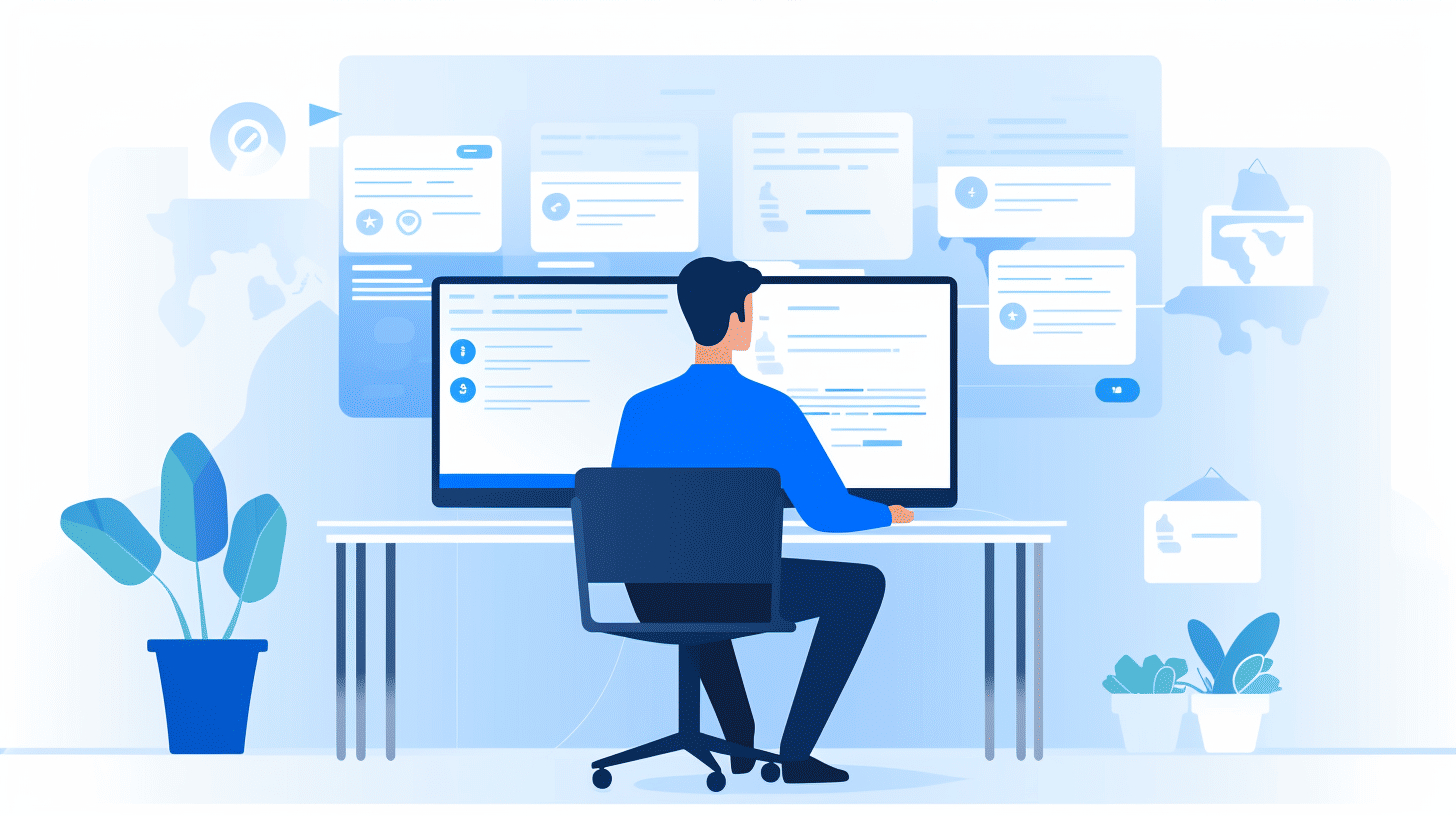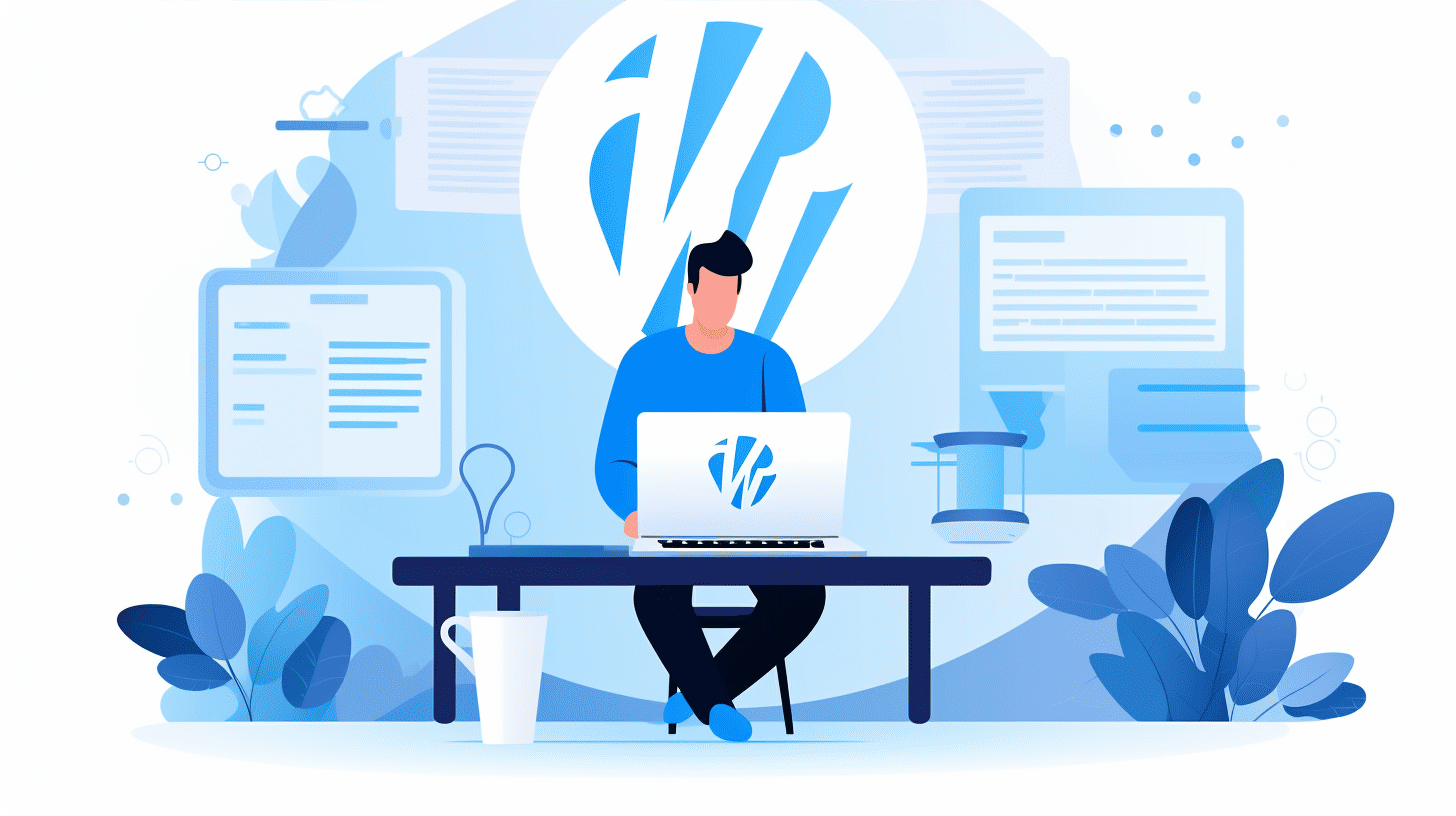在當今的數位世界中,對於任何希望建立強大網路影響力的企業或個人來說,擁有網站都至關重要。 WordPress 憑藉其用戶友好的介面和廣泛的自訂選項,已成為最受歡迎的網站建立平台之一。然而,建立網站只是您的線上旅程的第一步。為了確保您的網站順利運作並保持安全,定期維護至關重要。
🌟 有效的網站維護涉及各種任務,例如更新 WordPress 核心、外掛程式和主題、實施安全措施、監控網站效能、優化載入時間等。這聽起來可能讓人不知所措,但不要害怕!本文將引導您了解有效的網站維護策略和節省時間的策略。
那麼,為什麼網站維護很重要?原因如下:
- 平穩、安全的運作: 定期更新您的 WordPress 網站有助於增強其功能和安全性。過時的軟體可能會使您的網站容易受到安全漏洞和相容性問題的攻擊。
- 資料安全: 備份您的網站就像擁有保單一樣。如果因硬體故障、駭客攻擊或人為錯誤而導致資料遺失,最近的備份可確保您能夠快速將網站還原到先前的狀態。
- 增強性能: 定期監控和優化您的網站可以提高其載入速度、使用者體驗和搜尋引擎可見度。性能良好的網站有助於提高用戶參與度和轉換率。
- 更新內容: 保持網站內容更新對於吸引和留住訪客至關重要。定期檢視和更新您的內容可確保您提供的資訊的準確性和相關性。
維護您的 WordPress 網站並不一定是一項艱鉅的任務。透過正確的策略和工具,您可以有效地管理您的網站並節省寶貴的時間。讓我們深入研究網站維護的各個方面並探索每個領域的可行策略。因此,請繫好安全帶,準備讓您的網站大放異彩!
定期更新以確保平穩、安全的運行
在這個快節奏的數位世界中,保持您的網站更新是維持其順暢和安全運行的重要部分。定期更新您的 WordPress 核心、主題和外掛程式可確保您的網站保持優化、免受安全漏洞的侵害並配備最新的功能和改進。
WordPress 核心更新
WordPress 核心是您網站的基礎,它會不斷發展以滿足線上環境不斷變化的需求。定期更新 WordPress 核心可為您帶來多種好處,例如:
- 增強安全性: 更新通常包括安全補丁,以解決漏洞並保護您的網站免受潛在威脅。透過保持更新至最新版本的 WordPress,您可以降低網站被惡意行為者攻擊的風險。
- 改進的性能: 核心更新通常伴隨著效能的增強,使您的網站更快、更有效率。這可以為您的訪客帶來更好的用戶體驗,並提高搜尋引擎結果頁面的排名。
- 新特性和功能: 更新還為 WordPress 平台引入了新功能和功能,讓您可以利用網頁設計和開發方面的最新創新。例如,表情符號是在 WordPress 核心更新中引入的,使您能夠為您的網站增添個人化和視覺吸引力。
主題和外掛更新
主題和外掛是您的 WordPress 網站的重要組成部分,因為它們提供使您的網站獨一無二的設計和功能。保持更新非常重要,原因如下:
- 錯誤修復: 主題和外掛開發人員經常發布更新來解決和修復舊版本中可能存在的錯誤或錯誤。透過更新這些元素,您可以確保您的網站順利運作且不會出現任何故障。
- 相容性: 技術不斷發展,主題和外掛的更新通常會提高與最新版本的 WordPress 以及其他基本工具和外掛程式的兼容性。透過保持最新版本,您可以避免由於版本過時而可能出現的衝突和相容性問題。
- 安全增強: 與 WordPress 核心一樣,主題和外掛也可能存在安全漏洞。透過定期更新,您可以最大限度地降低網站被已知漏洞利用的風險,並確保網站及其資料的安全。
定期更新您的 WordPress 核心、主題和外掛是網站維護的一個重要方面。透過這樣做,您可以確保您的網站保持安全、順利運行並受益於最新的功能和改進。有關簡化網站維護程序的更多提示,請查看我們的綜合指南 網站維護技巧.
資料安全備份措施
🔒 在當今的數位世界中,確保資料安全至關重要。由於網路威脅和意外的技術故障總是潛伏著,因此制定強大的備份措施至關重要。定期備份您的網站是保護您的重要資訊並確保在出現任何問題時快速恢復的主動步驟。
執行網站備份
定期備份您的網站可以避免以後可能發生的麻煩。以下是您應該優先考慮備份的一些主要原因:
- 資料保護:網站備份可作為防止伺服器崩潰、駭客攻擊或惡意軟體感染等不可預見事件的保護盾。透過取得網站資料的最新副本,如果發生任何不幸的事件,您可以快速有效地恢復它。
- 輕鬆恢復:想像一下,當您醒來時發現您的網站已經從網路上消失了。如果沒有備份,恢復您的網站可能是一個耗時且昂貴的過程。但是,透過定期備份,您可以快速恢復您的網站正常運行,從而最大限度地減少停機時間和潛在的收入損失。
- 安心:知道您的資料已安全備份,您就安心了。無論您是經營小型部落格還是管理大型電子商務平台,備份都可以確保您從任何挫折中恢復過來而不會造成重大中斷。
- 版本控制:備份可讓您維護網站的多個版本,特別是當您經常進行變更或更新時。如果您需要還原到網站的先前版本或比較不同的版本,此功能非常方便。
為了有效地執行網站備份,請考慮以下最佳做法:
- 自動備份解決方案:利用自動備份工具或外掛程式根據您的偏好安排定期備份。這樣,您就不必記住手動執行備份,從而降低了忽視這項關鍵任務的風險。
- 異地存儲:將備份儲存在異地位置,例如雲端儲存或外部硬碟。這種方法可確保即使您的伺服器或網站發生災難性故障,您的備份仍將保持安全且可存取。
- 測試和修復:定期測試您的備份並練習恢復它們以確保它們正常運作。這種做法有助於識別備份過程中的任何問題並確保您的復原過程萬無一失。
請記住,備份的頻率取決於您網站的性質及其內容變化的速度。一般經驗法則是定期進行備份,例如每天、每週或每月,具體取決於您網站的活動。
總而言之,透過定期備份,您不僅可以保護寶貴的數據,還可以獲得信心來處理可能遇到的任何潛在威脅或事故。這是對您網站安全性和壽命的投資,使您能夠專注於您最擅長的領域。
因此,立即開始實施備份措施,確保您的數字有安心。 🛡️
加強安全措施
在當今的數位環境中,確保您網站的安全至關重要。隨著網路威脅的不斷增加,採取主動措施保護您的線上狀態免受惡意軟體和駭客攻擊至關重要。最有效的方法之一是定期檢查您的網站是否有安全漏洞。
🔒 網站安全漏洞檢查
檢查您的網站是否有安全漏洞是加強防禦的關鍵步驟。透過定期進行安全漏洞檢查,您可以識別潛在的弱點,並在被惡意行為者利用之前解決它們。以下是應優先進行這些檢查的幾個原因:
- 防範惡意軟體:透過識別和修補網站程式碼中的漏洞,您可以大幅降低惡意軟體感染的風險。定期進行安全漏洞檢查可以幫助您領先一步防禦潛在的惡意軟體攻擊。
- 防止資料外洩:網站漏洞可以作為駭客未經授權存取您寶貴資料的入口點。透過徹底的安全檢查,您可以降低資料外洩的風險並保護使用者和客戶的敏感資訊。
- 維護客戶信任:確保您網站的安全和隱私可以贏得使用者和客戶的信任。透過證明您非常重視安全,您可以提高您的聲譽並將自己確立為可靠的線上實體。
要對您的網站進行全面的安全檢查,請考慮使用信譽良好的網站安全保護服務,例如 管理WP防火牆。透過利用他們的專業知識和先進的安全工具,您可以掌握潛在的漏洞並有效地保護您的網站。
請記住,投資網站安全是一個持續的過程。定期更新您的軟體、採用強大的身份驗證措施以及了解最新的安全實踐都是強大的網站安全策略的重要組成部分。透過這些主動措施,您可以增強網站的安全性並保護其免受潛在威脅。
🔒 保持安全,保持安心!
監控網站效能
在當今的數位環境中,擁有一個高效能的網站對於企業和個人來說都至關重要。由於有如此多的網站爭奪關注,監控網站的效能以確保無縫的用戶體驗並提高搜尋引擎排名至關重要。透過定期監控和解決可能出現的任何問題,您可以保持健康的線上狀態並保持訪客的參與度。在本文中,我們將探討效能監控的重要性,並為您提供一些有價值的見解,以幫助您優化網站以獲得成功。
效能監控
效能監控是指持續評估和分析影響網站效能的各種指標和因素的過程。透過密切注意這些元素,您可以發現潛在的瓶頸、技術問題和需要改進的領域。以下是網站效能方面需要監控的一些關鍵領域:
- 頁面載入速度:訪客進入您的網站時首先註意到的事情之一就是它的載入速度。載入時間緩慢可能會讓人沮喪,跳出率也會很高。監控您網站的頁面載入速度可以幫助您確定需要進行的任何優化,例如優化圖片、利用瀏覽器快取或最小化 CSS 和 JavaScript 檔案。
- 回應能力:隨著行動裝置使用量的增加,您的網站具有響應能力且適合行動裝置變得至關重要。確保您的網站能夠很好地適應不同的螢幕尺寸和裝置對於提供無縫的用戶體驗至關重要。定期監控您網站的回應能力可以幫助您發現任何問題並進行必要的調整。
- 停機時間:網站停機會對使用者體驗和可訪問性產生重大影響。監控您的網站的正常運作時間並及時解決任何中斷或技術問題可以幫助最大限度地減少停機時間並確保您的網站始終可供訪客存取。
- 轉換率:高效能的網站不僅僅具有速度和響應能力。監控網站的轉換率也很重要——它實現預期目標的程度,例如填寫表格、進行購買或註冊新聞通訊。分析這些指標可以幫助您確定網站可能需要改進的領域,以增強使用者體驗並提高轉換率。
透過定期監控這些效能指標,您可以掌握任何問題並做出數據驅動的決策來優化您網站的效能。請記住,表現良好的網站不僅可以提供更好的用戶體驗,還可以提高搜尋引擎排名,從而提高知名度和流量。
現在我們了解了效能監控的重要性,讓我們深入了解一些實用的技巧和策略,以幫助您優化網站以獲得最佳效能。
檢討並更新網站內容
在當今的數位環境中,注意力持續時間越來越短,資訊過載成為常態,企業定期審查和更新其網站內容至關重要。這不僅有助於確保您的網站保持相關性和專業性,而且還能提高您的搜尋引擎可見性和用戶體驗。這就是為什麼必須優先進行內容審核和更新的原因:
- 保持相關性: 您的網站通常是您的企業與潛在客戶之間的第一個接觸點。過時或不相關的內容會給人留下負面印象並趕走訪客。透過定期檢視和更新您的內容,您可以確保它準確反映您的品牌,展示您的產品或服務,並滿足目標受眾的需求。
- 改善搜尋引擎優化: 搜尋引擎演算法不斷發展,它們青睞那些提供新鮮且經常更新內容的網站。定期以新的部落格文章、文章或產品描述更新您的網站可以幫助提高您的搜尋引擎排名並增加您的自然流量。這也是一個整合相關關鍵字並優化內容以獲得更好可見性的機會。
- 增強使用者體驗: 您的網站應該為訪客提供無縫且愉快的體驗。過時的資訊或斷開的連結會讓用戶感到沮喪,並讓他們質疑您的可信度。透過更新您的內容、修復斷開的連結以及改善整體用戶介面,您可以創造積極的印象並增加網站的參與度。
- 展現專業知識: 作為一家企業,您希望確立自己在行業中的權威地位。定期更新您的網站內容可以讓您與受眾分享您的知識和專業技能。透過發布文章、指南或案例研究等資訊豐富且有價值的內容,您可以將自己定位為值得信賴的資源並吸引忠實的客戶。
那麼,您應該多久檢視和更新一次您的網站內容?雖然沒有放諸四海皆準的答案,但建議制定內容審查計畫。這可能是每季、每半年或每年一次,具體取決於您的業務性質和行業變化的頻率。
請記住,審查和更新您的網站內容是一個持續的過程。透過投入時間和資源來完成這項任務,您可以確保您的網站保持新鮮、相關,並對搜尋引擎和目標受眾具有吸引力。
你可知道? 根據 HubSpot 的一項調查,每月發布 16 篇或更多部落格文章的公司比發布 0 到 4 篇文章的公司獲得的流量幾乎多 3.5 倍。定期以高品質的內容更新您的部落格可以顯著影響您網站的知名度和成功率。
因此,不要讓您的網站內容積滿數位灰塵。投入定期審查和更新以保持競爭優勢並最大限度地提高您的線上影響力。
增強效能和安全性
在運行網站時,效能和安全性是兩個不容忽視的重要方面。性能良好且安全的網站不僅可以提供更好的用戶體驗,而且還有助於提高您的搜尋引擎排名。在本節中,我們將討論兩個可以顯著提高您網站的效能和安全性的關鍵因素:選擇良好的託管服務和優化您的 WordPress 主題。
選擇良好的託管服務
您選擇的託管服務是可能極大影響您網站效能和安全性的主要因素之一。良好的託管服務可以提供必要的基礎設施和資源,以確保您的網站順利且安全地運作。選擇託管服務時需要考慮以下幾點:
- 可靠性: 尋找提供可靠正常運作時間保證的託管服務,最好是 99.9% 或更高。這可確保您的網站始終可供訪客訪問,而不會出現任何停機時間。
- 可擴充性: 考慮一種託管服務,它允許您隨著網站的發展輕鬆擴展資源。這可確保當您的網站開始接收更多流量時,您不會遇到任何限製或效能問題。
- 安全措施: 尋找實施強大安全措施的託管服務,例如防火牆、惡意軟體掃描和定期備份。這有助於保護您的網站及其資料免受潛在威脅。
- 技術支援: 檢查託管服務是否提供全天候技術支援。如果您遇到任何問題或需要協助,獲得可靠的支援將會產生很大的幫助。
- 託管 WordPress 主機: 考慮選擇託管的 WordPress 主機,它提供專門針對 WordPress 網站的專用基礎設施和支援。託管 WordPress 託管服務,例如 WordPress 託管,負責定期更新、備份、安全掃描和效能最佳化,讓您專注於創建精彩內容和經營您的業務。
優化 WordPress 主題
除了選擇正確的託管服務之外,優化您的 WordPress 主題可以顯著提高您網站的效能和安全性。以下是優化 WordPress 主題的一些技巧:
- 選擇輕量級主題: 選擇輕量級且針對速度進行最佳化的 WordPress 主題。避免使用帶有過多特性和功能的臃腫主題,因為它們會降低您網站的效能。
- 最小化插件: 注意您在網站上安裝的插件的數量和品質。每個外掛程式都可以添加額外的程式碼和功能,這會影響您網站的速度和安全性。僅安裝必要的插件,並定期檢查和刪除任何未使用或不必要的插件。
- 優化影像: 大圖像會佔用寶貴的伺服器資源並降低您的網站速度。透過壓縮來優化您的影像,而不會損失品質。您可以使用外掛程式或線上工具來優化圖像,然後再將其上傳到您的 WordPress 網站。
- 使用快取: 在您的 WordPress 網站上實作快取機制來儲存網頁的靜態版本。快取可減少伺服器的負載並加快回訪者的頁面載入時間。
- 定期更新: 保持您的 WordPress 主題和外掛程式為最新版本,以確保您擁有最新的安全性修補程式和效能增強功能。定期更新有助於保護您的網站免受漏洞並確保其順利運作。
將這些做法納入您的網站維護例程中,可以大大提高效能和安全性,為您的訪客創造更好的體驗,並最終有助於您在線形象的成功。
優化技術
想像一下造訪一個需要很長時間才能載入的網站。真令人沮喪,不是嗎?網站速度慢不僅會讓訪客感到厭煩,還會對搜尋引擎排名產生負面影響。這就是為什麼實施快取和優化技術對於提高網站速度和效能至關重要。
快取:加速您的網站
快取是將網頁、圖像和其他資源的臨時副本儲存在使用者裝置或伺服器上的過程。它允許瀏覽器透過檢索儲存的資料而不是每次都從伺服器獲取資料來更快地載入網站。這就是為什麼快取可以徹底改變網站優化:
- 更快的頁面載入時間:有了快取數據,後續造訪網站的速度就會變得非常快。用戶不必等待伺服器重複處理相同的請求。
- 減少伺服器負載:快取透過直接從快取提供靜態內容來減少伺服器的工作負載。這有助於優化伺服器效能並處理更多並髮用戶而不會降低速度。
- 改善使用者體驗:快速加載的網站意味著更好的用戶體驗。如果訪客不需要處理漫長的載入時間,他們就更有可能保持參與、瀏覽更多頁面並轉換為客戶。
優化技術:速度和效率的微調
除了快取之外,您還可以實施其他幾種優化技術來提高網站的效能:
- 縮小:縮小網站的 HTML、CSS 和 JavaScript 檔案涉及刪除不必要的字符,例如空格、換行符和註釋。這可以減小檔案大小並縮短載入時間。
- 影像壓縮:在不犧牲品質的情況下壓縮檔案大小來優化影像對於加快載入時間至關重要。這可以使用圖像壓縮工具或插件來實現。
- 程式碼最佳化:檢查您網站的程式碼並進行必要的優化可能會對效能產生重大影響。這包括刪除未使用或冗餘的程式碼、最佳化資料庫查詢和改進伺服器端腳本。
- 內容傳遞網路 (CDN):CDN 是地理分佈的伺服器網絡,用於從最近的伺服器位置向使用者提供網絡內容。這有助於減少延遲並提高全球網站效能。
請記住,實施這些優化技術需要技術專長和知識。如果您不熟悉 Web 開發,最好諮詢專業人士或使用可自動執行這些流程的外掛程式。
優化您的網站不僅可以改善用戶體驗,還可以提高您在搜尋引擎中排名更高的機會。因此,請採取必要的措施來加快您的網站並為您的訪客提供無縫的瀏覽體驗。 🚀
實施快取和優化技術可顯著提高網站速度和效能。
提高可視性和使用者體驗
在當今的數位環境中,擁有強大的線上影響力對於各種規模的企業來說都至關重要。實現此目標的一種方法是提高網站的可見性和使用者體驗。透過定期檢查斷開的連結並優化您的網站,您可以提高其效能,吸引更多訪客,並最終推動更多轉換。
檢查斷開的鏈接
斷開的連結可能會嚴重損害您網站的可見性和用戶體驗。當用戶點擊指向 404 錯誤頁面或死胡同的連結時,這不僅會讓他們感到沮喪,而且還會向搜尋引擎發送負面訊號。斷開的連結可能會對您網站的 SEO 產生負面影響,導致其在搜尋引擎排名中下降。
為了防止這種情況發生,定期檢查網站上的斷開連結非常重要。您可以採取以下幾個步驟:
- 使用連結檢查工具:有幾種線上工具可以掃描您的網站以查找已斷開的連結。這些工具會爬行您的網站並識別任何指向不存在或無法訪問的頁面的連結。
- 修復或刪除損壞的鏈接:一旦您確定了斷開的鏈接,請採取必要的步驟來修復它們。這可能涉及更新 URL、完全刪除連結或將其重定向到相關頁面。
- 監控您的網站:定期監控您的網站,以確保不會出現新的斷開的連結。這可以透過設定警報或使用監控工具來實現,當偵測到斷開的連結時會通知您。
透過定期檢查斷開的連結並及時修復,您可以改善網站的用戶體驗並確保搜尋引擎對您的網站有良好的印象。
搜尋引擎優化
搜尋引擎優化(SEO)在提高您網站的可見度方面起著至關重要的作用。透過優化您網站的內容、結構和其他元素,您可以增加其在搜尋引擎結果頁面(SERP)上排名更高的機會。以下是一些需要考慮的關鍵 SEO 做法:
- 關鍵字研究:確定您的目標受眾可能搜尋的相關關鍵字和短語。將這些關鍵字策略性地融入您的網站的內容、元標籤、標題和 URL 中。
- 高品質內容:創造引人入勝、內容豐富且原創的內容,為您的受眾提供價值。搜尋引擎青睞提供高品質內容的網站,因此請確保投入時間和精力來創建相關且有價值的資源。
- 行動最佳化:隨著越來越多的用戶透過行動裝置存取互聯網,對您的網站進行行動優化至關重要。確保您的網站響應迅速並在所有裝置上提供無縫的用戶體驗。
- 頁面速度優化:使用者希望網站能夠快速加載,而搜尋引擎則優先考慮快速加載的網站。透過壓縮圖片、縮小 CSS 和 JavaScript 以及利用瀏覽器快取來優化網站的頁面速度。
- 連結建設:為您的網站建立高品質的入站連結可以提高其權威性和知名度。專注於透過客座部落格、影響力拓展和內容推廣等策略從信譽良好且相關的來源獲取連結。
透過實施這些 SEO 實踐,您可以提高網站在搜尋引擎結果中的可見性,並使您的目標受眾更容易發現它。
定期檢查斷開的連結並優化您的網站可以提高其可見性和用戶體驗。透過花時間確保您的網站正常運作並針對搜尋引擎進行了優化,您可以吸引更多訪客,留住他們更長時間,並最終實現更多轉換。所以,不要忽視這些做法的重要性——它們可以對您的線上形象的成功產生重大影響。
備份和資料保護
在我們日益數位化的世界中,備份和資料保護的重要性怎麼強調也不為過。無論您是個人還是企業,保護您寶貴的資料對於確保其完整性和防止資料遺失造成的災難性後果至關重要。 🗂️💻
資料備份和存儲
保護資料最有效的方法之一是定期建立備份並將其儲存在多個位置。這種簡單但強大的做法提供了額外的保護層,防止意外刪除、硬體故障、惡意軟體攻擊和其他不可預見的事件。透過在不同的地方儲存資料的副本,您可以降低一下子遺失所有資料的風險。 💾🔒
以下是資料備份和儲存的一些主要優點:
- 資料恢復:如果發生資料遺失,透過備份您可以輕鬆恢復檔案並最大限度地減少停機時間。無論是硬碟崩潰還是勒索軟體攻擊,備份都可以確保您的資料不會永遠丟失。
- 防止意外刪除:我們都曾經遇到過這種情況——意外刪除了重要的檔案或資料夾。有了備份,您可以輕鬆檢索遺失的資料。它就像一張安全網,讓您安心地知道您的資訊是可以恢復的。
- 硬體故障保護:硬碟可能會在沒有警告的情況下發生故障,導致您無法存取資料。透過定期備份文件,您可以降低因硬體故障而丟失所有內容的風險。即使一個儲存裝置發生故障,您也可以依靠備份來檢索重要文件。
- 防禦惡意軟體和網路攻擊:惡意軟體和網路攻擊日益增多,它們會嚴重破壞您的資料。有了備份,您可以在遭受成功攻擊時恢復文件,從而最大限度地減少對您的業務或個人生活的影響。
請記住,建立備份並將其儲存在多個位置可以提供額外的保護並確保資料完整性。無論您選擇使用外部硬碟等實體儲存裝置還是利用基於雲端的備份解決方案,關鍵是使其成為資料保護策略的常規組成部分。不要等到為時已晚—今天就開始備份您的重要資料! 🛡️📂
利用測試環境降低風險
在軟體開發和網站維護領域,在實施更新或變更時盡量減少意外問題或停機的風險至關重要。這時,利用測試環境或暫存站點就變得非常有價值了。
使用測試環境
測試環境是一個獨立且隔離的環境,開發人員可以在將變更部署到即時站點之前安全地測試和試驗變更。它作為一個受控空間,供開發人員識別和糾正測試階段可能出現的任何錯誤或問題,從而降低影響生產環境的風險。
以下是利用測試環境的一些主要好處:
- 風險緩解: 透過在專用環境中進行全面的測試,開發人員可以在問題破壞即時網站之前發現並解決問題。這有助於防止可能造成高昂代價並損害使用者體驗的意外錯誤和停機。
- 確保相容性: 透過測試環境,開發人員可以確保任何更新或變更與現有基礎設施、軟體版本和第三方整合相容。這可以防止潛在的衝突或相容性問題導致即時環境中斷。
- 簡化的工作流程: 測試環境為開發人員提供了一個安全的空間,使他們能夠協作、測試想法並迭代更改,而不會影響生產環境。這允許開發人員並行工作並彼此獨立地測試更改,從而促進更簡化的工作流程。
- 提高品質保證: 透過在受控環境中進行嚴格測試,開發人員可以在錯誤、安全漏洞和可用性問題影響最終用戶之前發現並修復它們。這有助於維護高品質且可靠的產品或網站。
- 部署信心: 透過在測試環境中徹底測試更改,開發人員在將程式碼部署到即時網站之前可以對其程式碼的穩定性和可靠性充滿信心。這減少了與推出更新相關的不確定性,並確保了更順暢的部署過程。
對於組織來說,優先考慮測試環境的實施和利用作為其開發和更新過程的一部分至關重要。透過這樣做,他們可以顯著降低意外問題的風險,提高其產品或網站的質量,並最終提供更好的用戶體驗。
專業維護服務
對於您的網站來說,優先考慮維護以確保最佳的安全性和效能至關重要。但讓我們面對現實,並不是每個人都有時間或專業知識來處理網站維護的細節。這就是專業維護服務的功能所在。
聘請 WordPress 維護服務
最受歡迎和最廣泛使用的內容管理系統之一是 WordPress。由於其靈活性和用戶友好的介面,難怪數以百萬計的網站都採用 WordPress。然而,管理 WordPress 網站需要持續關注和定期更新才能保持其順利運作。
以下是聘請專業 WordPress 維護服務是明智之舉的一些原因:
- 專家協助: 當您聘請專業維護服務時,您可以接觸到專門從事 WordPress 的專家團隊。他們擁有處理可能出現的任何與網站相關的問題的知識和專業技能。無論是更新外掛、排除錯誤或優化效能,他們都能為您提供協助。
- 網站安全: 隨著網路安全威脅的不斷增加,採取強有力的安全措施來保護您的網站和使用者資料至關重要。專業維護服務精通實施安全最佳實踐,例如定期惡意軟體掃描、防火牆保護和安全備份。透過將您的網站委託給專業人士,您可以放心,您的網站受到良好的保護,免受潛在威脅。
- 改進的性能: 加載緩慢的網站會趕走訪客並對您的業務產生負面影響。專業維護服務可以透過實施快取技術、資料庫優化和圖像壓縮來優化您網站的效能。他們將確保您的網站快速加載,提供出色的用戶體驗並提高您的搜尋引擎排名。
- 節省時間和成本: 透過將您的網站維護外包給專業人士,您可以騰出寶貴的時間用於業務的其他重要方面。此外,從長遠來看,聘請維護服務可以節省成本。您無需處理意外的網站問題並支付高額的緊急修復費用,定期維護可以幫助預防潛在問題並從長遠來看為您節省金錢。
簡而言之,聘請專業的 WordPress 維護服務可以提供專家的幫助,並對網站安全和效能充滿信心。這是一項明智的投資,可以讓您專注於您的核心業務,同時將您網站的技術方面交給有能力的人。
如果你正在尋找可靠且全面的 WordPress 維護服務,請務必查看 WordPress 支援服務。他們的專家團隊致力於確保您的網站順利、安全地運行,以便您可以專注於最重要的事情——您的業務。
增強使用者體驗和參與度
您是否曾經造訪過難以導航或視覺效果令人難以接受的網站?這很令人沮喪並且會阻止你在該網站上花費更多時間。這就是為什麼企業必須優先考慮使用者體驗和參與度。透過創建積極的線上環境,他們可以保持訪客的參與並讓他們再次訪問。
網站佈局和主題選擇
網站的佈局和主題對於創造愉快的使用者體驗起著重要作用。原因如下:
- 輕鬆導航:乾淨整潔的網站佈局可以讓使用者更輕鬆地找到他們想要的內容。透過清晰的選單、直覺的導覽列和組織得當的內容,訪客在瀏覽您的網站時不會迷路或感到沮喪。請記住,滿意的用戶才是忠誠的用戶!
- 行動友善體驗:在我們的數位時代,行動裝置為王。大多數網路使用者透過智慧型手機或平板電腦造訪網站。因此,選擇針對行動裝置最佳化的主題至關重要。這意味著響應式設計和靈活的佈局可以無縫適應不同的螢幕尺寸。透過迎合行動用戶,您可以確保您的網站為廣大受眾提供最佳體驗。
- 視覺吸引力:美學很重要!精心設計的主題會給人留下正面的第一印象並吸引訪客的注意。一個具有精心挑選的顏色、字體和圖形的視覺吸引力的網站可以讓您的品牌看起來更加專業和值得信賴。此外,它有助於創建與目標受眾產生共鳴的一致視覺識別。
- 頁面載入速度:您知道頁面載入速度可以決定使用者體驗的好壞嗎?載入緩慢的網站會讓使用者感到沮喪,導致跳出率更高、參與度更低。透過選擇具有高效程式碼和優化圖像的主題,您可以確保您的網站快速加載,讓訪客感到滿意並參與其中。
總之,選擇正確的網站佈局和主題對於增強用戶體驗和參與度至關重要。透過保持乾淨整潔的佈局,並選擇具有視覺吸引力的行動友善主題,企業可以創造一個溫馨的線上環境,讓訪客再次光臨。
因此,下次您考慮改造網站時,請記住優先考慮使用者體驗和參與度。這不僅關乎美學——還關乎為訪客創造積極、無縫的體驗。
重要軟體更新
在不斷發展的技術領域,保持您的網站更新對於確保其安全性和功能至關重要。忽略網站的軟體更新(包括 WordPress 核心、外掛和主題)可能會導致您的網站容易受到安全漏洞的攻擊並影響其效能。
定期更新您的網站軟體不是一次性任務,而是持續的過程。它需要注意力和勤奮,但其收益遠遠超過所需的努力。這就是為什麼保持軟體更新至關重要:
- 增強安全性:網路威脅不斷演變,駭客總是在尋找可利用的漏洞。透過定期更新您的軟體,您可以領先一步防禦這些威脅。軟體更新通常包含修復程式和補丁,用於解決早期版本中發現的安全漏洞。忽略更新可能會導致您的網站容易受到攻擊、資料外洩和惡意軟體感染。
- 提高性能:軟體更新不僅解決安全性問題,也優化效能。開發人員不斷致力於提高其軟體的效率和功能。透過保持 WordPress 核心、外掛和主題更新,您可以受益於錯誤修復、效能增強和新功能。這最終將為您的網站訪客帶來更流暢、更愉快的體驗。
- 與新技術的兼容性:隨著技術的進步,軟體需要適應並與新工具和平台無縫整合。過時的軟體可能與最新的網路技術不相容,從而導致相容性問題和潛在錯誤。透過保持最新狀態,您可以確保您的網站保持完全功能並與新設備、瀏覽器和新興技術相容。
- 存取新功能:軟體更新通常會帶來令人興奮的新功能和功能。這些更新可以為您提供改進的設計選項、增強的使用者體驗和提高的效率。透過保持軟體更新,您可以利用這些創新並確保您的網站始終處於最新趨勢的前沿。
為了讓軟體更新過程更加順暢且更省時,請考慮實施以下最佳做法:
- 備份您的網站:在套用任何更新之前,請確保備份您的網站。此預防步驟可確保您有還原點,以防更新過程中出現任何問題。
- 逐步更新:首先更新您的 WordPress 核心,然後前往外掛程式和主題。這種循序漸進的方法可讓您一次解決任何潛在問題,從而最大限度地減少相容性問題並降低網站停機的風險。
- 更新後測試:應用軟體更新後,請徹底測試您網站的功能,以確保一切正常運作。關注聯絡表、電子商務功能和網站導航等關鍵領域。
請記住,保持積極主動並定期更新您的網站軟體對於維護其安全性、效能和與新技術的兼容性至關重要。透過這樣做,您可以保護您的網站並為您的訪客提供最佳體驗。所以,不要延遲那些關鍵的軟體更新;今天就優先考慮它們!
“定期更新您的網站軟體就像穿上一套數位盔甲,保護您的網站免受安全威脅並保持其順利運行。”
確保安全和存取控制
在當今的數位環境中,確保您網站的安全絕對至關重要。隨著網路威脅和駭客攻擊的不斷增加,採取主動措施保護您的網站免受未經授權的存取至關重要。實現此目標的有效方法之一是透過定期的安全審計和實施存取控制實務。
執行定期安全審計
識別網站安全漏洞的最佳方法之一是進行定期安全審核。這些審核可以幫助您評估網站目前的安全狀況並識別可能使其面臨網路威脅的潛在弱點。透過審查您的安全措施,您可以採取必要的步驟來加強您的防禦並防止未經授權的存取。
以下是定期進行安全審核的一些主要好處:
- 識別漏洞:安全審計有助於識別您網站基礎架構、應用程式或流程中的任何漏洞或弱點。這使您能夠及時解決這些問題並最大限度地降低安全漏洞的風險。
- 保持領先:透過定期評估您的安全措施,您可以領先於潛在威脅並主動實施必要的變更。這可確保您了解最新的安全實務和標準。
- 保護敏感資料:安全審計有助於保護儲存在您網站上的敏感信息,例如使用者資料、財務詳細資訊和密碼。透過加強安全措施,您可以降低資料外洩的風險並維護用戶的信任。
實施存取控制實踐
除了安全審計之外,實施存取控制實務是網站安全的另一個重要面向。存取控制涉及管理和控制誰有權訪問您網站的不同部分以及他們可以執行的操作。這有助於防止未經授權的使用者存取敏感區域並保護您網站的資料和功能。
以下是一些關鍵的存取控制實務:
- 使用者身份驗證:實施安全的使用者身份驗證方法,例如強密碼、多因素身份驗證和 CAPTCHA,有助於在授予使用者存取權限之前驗證使用者的身份。
- 基於角色的存取控制:為使用者指派不同的角色和權限,讓您能夠控制他們可以在您的網站上執行哪些操作。這確保只有授權個人可以修改或存取敏感資訊。
- 定期檢視存取權限:定期檢視和更新存取權限可確保僅向個人授予必要的權限。這降低了未經授權的存取或濫用特權的風險。
透過將定期的安全審核與強大的存取控制實務結合,您可以顯著增強網站的安全性並保護其免受潛在威脅和未經授權的存取。
請記住,確保您網站的安全是一個持續的過程。保持警惕,保持最新的安全措施,並定期評估您網站的漏洞,以阻止任何潛在的網路攻擊。
資料保護和恢復
異地備份和資料存儲
資料保護對於任何企業或個人來說都至關重要。隨著對技術的依賴性越來越強,保護寶貴的資料免受潛在的遺失或損壞變得至關重要。資料保護的一個重要方面是異地備份和資料儲存。
為什麼異地備份很重要?
異地備份涉及建立資料副本並將其儲存在單獨的實體位置。此備份策略有多種好處,包括:
- 災難復原: 如果發生火災或天災等災難性事件,異地備份可確保您的資料安全。即使您的主資料儲存受到損害,您也可以輕鬆地從異地備份中還原您的資訊。
- 資料安全: 將資料儲存在多個位置可以增加額外的安全性。如果一個位置受到威脅,其他位置的備份不會受到影響。這降低了因盜竊或網路攻擊而導致資料遺失的風險。
- 數據冗餘: 異地備份提供冗餘,確保您的資料不會因硬體故障或損壞而遺失。在不同位置保存資料的多個副本可最大限度地減少資料完全遺失的可能性。
- 輕鬆檢索: 透過異地備份,您可以在意外刪除、資料損壞或系統故障時快速還原資料。它提供了無縫的資料恢復過程,最大限度地減少停機時間並確保業務連續性。
在多個位置儲存網站數據
對於嚴重依賴網站的企業來說,考慮專門針對其線上業務的資料保護措施至關重要。將網站資料儲存在多個位置可以提供額外的資料安全性和復原優勢。這種方法包括:
- 地理冗餘: 透過將您的網站資料的副本儲存在不同的地理位置,您可以最大限度地降低在發生影響特定區域的災難時資料完全遺失的風險。它確保即使發生局部中斷或損壞,您的網站仍然可以訪問。
- 更快的內容傳遞: 將網站資料儲存在多個位置允許從距離請求資訊的使用者最近的位置傳遞內容。這可以減少延遲並提高網站效能,確保流暢的用戶體驗。
- 流量分佈: 將您的網站資料分佈到多個位置有助於分散傳入的流量。這可以防止任何單一位置超載並確保有效處理使用者請求。
透過利用異地備份並將網站資料儲存在多個位置,企業可以確保其寶貴資訊的安全性並最大限度地減少任何潛在資料遺失或損壞的影響。請記住,資料保護不僅僅是預防,還包括準備和快速恢復。
使用異地備份並將網站資料儲存在多個位置可確保資料安全並輕鬆復原。
維護模式帶來愉悅的使用者體驗
實施維護模式
當涉及網站更新和變更時,使用者體驗始終是首要考慮的。畢竟,沒有人喜歡偶然發現一個半成品的網站或遇到斷開的連結。這就是維護模式的作用所在。
維護模式本質上允許您暫時使您的網站離線以進行更新、修復或改進。它向訪客顯示一條友好的訊息,讓他們知道網站目前正在維護,很快就會恢復。這有助於管理使用者期望並減少挫折感,因為訪客知道他們遇到的任何問題或變更都是持續維護過程的一部分。
那麼,您究竟該如何在您的網站上實現維護模式呢?以下是幾個簡單的步驟:
- 選擇維護模式外掛: 有幾種適用於 WordPress 等流行網站平台的插件,讓啟用維護模式變得輕而易舉。尋找一個在客製化選項、設計和易用性方面適合您需求的產品。
- 自訂維護頁面: 安裝外掛程式後,就可以自訂維護頁面來反映您的品牌並告知訪客正在進行的維護。新增一條友善訊息、一個進度條以顯示更新完成的程度以及任何其他相關資訊。
- 決定誰可以造訪該網站: 維護模式外掛程式通常允許您控制誰可以在維護期間存取網站。您可以將特定的 IP 位址列入白名單(如果您想允許某些個人或團隊繼續在網站上工作,這很有用)或設定訪客需要輸入才能查看網站的臨時存取代碼。
- 安排維護期: 為維護模式設定具體的開始和結束日期。這可以確保訪客了解網站何時恢復上線,並有助於管理預期。
- 與您的電子郵件行銷或社交媒體工具整合: 利用維護模式期與您的觀眾互動。使用電子郵件行銷或社群媒體平台通知訂閱者或追蹤者即將進行的維護,並提供偶爾的進度更新。
請記住,實施維護模式是網站更新期間提供無縫使用者體驗的關鍵步驟。透過讓訪客了解情況並管理他們的期望,您可以確保正在進行的變更不會對您網站的功能或聲譽產生負面影響。
優化載入時間
您是否曾經造訪過一個需要很長時間載入的網站?這可能是一種令人沮喪的體驗,研究表明,用戶更有可能放棄加載緩慢的網站。這不僅會導致糟糕的用戶體驗,還會對您的搜尋引擎排名產生負面影響。
為了確保您的網站快速順暢地加載,進行速度審核並優化其加載時間至關重要。那麼,該如何做呢?讓我們深入研究並找出答案!
速度審計與優化
執行速度審核可以讓您識別網站可能滯後並導致速度變慢的區域。透過分析影響載入時間的各種因素,您可以找出需要解決的具體問題。以下是一些需要考慮的關鍵步驟:
- 評估伺服器回應時間: 伺服器回應請求所需的時間會嚴重影響載入速度。回應時間緩慢可能是由多種因素造成的,例如伺服器配置或高流量。優化伺服器回應時間可確保您的網站能夠為所有訪客快速載入。
- 優化圖片大小: 大型圖像檔案是導致網站載入緩慢的最常見原因之一。透過壓縮圖像或使用更適合網路的格式,您可以減小檔案大小而不影響圖像品質。這種簡單的優化技術可以顯著改善載入時間。
- 最小化 CSS 和 JavaScript 檔案: CSS 和 JavaScript 檔案可能會導致程式碼臃腫,從而降低網站速度。縮小這些檔案包括刪除不必要的空格、註解和未使用的程式碼。透過減小檔案大小,您的網站的載入時間可以顯著改善。
- 利用瀏覽器快取: 瀏覽器快取允許將某些檔案儲存在使用者的裝置上,從而減少了每次造訪網站時從伺服器取得這些檔案的需要。透過設定 CSS 和 JavaScript 檔案等靜態資源的到期日期,您可以啟用快取並提高回訪者的載入速度。
- 考慮內容傳遞網路(CDN): CDN 將您網站的靜態檔案分發到世界各地的多個伺服器上,讓使用者可以從其所在地附近的伺服器存取您的內容。透過縮短與伺服器的實體距離,您的網站可以載入得更快,從而提供更好的使用者體驗。
透過進行全面的速度審核並根據審核結果實施優化,您可以大幅提高網站的載入時間。這不僅會為您的用戶帶來更流暢的瀏覽體驗,還可以提高您的搜尋引擎排名。
請記住,在當今快節奏的網路世界中,分分秒秒都至關重要。因此,請確保優化網站的加載時間,以創造積極的印象並保持訪客的參與! 👍
優化媒體文件
在數位時代,圖像、視訊和音訊等媒體檔案在吸引和吸引網站訪客方面發揮著至關重要的作用。但是,如果沒有進行適當的最佳化,這些文件也會減慢網站的載入速度。這就是媒體文件的外部託管發揮作用的地方。
外部託管是指將媒體檔案上傳到 YouTube 或 Vimeo 等平台而不是直接託管在您的網站上的做法。此策略具有多種優勢,可協助提高您網站的整體效率。讓我們來探討一下其中的一些好處:
📈 提高網站效能: 外部託管媒體檔案可減輕您網站伺服器的負擔,使其能夠專注於向訪客提供其他重要內容。這有助於優化您的網站的載入速度並確保流暢的用戶體驗。
🏋️ 消除頻寬限制: 媒體文件,尤其是視頻,很快就會消耗大量頻寬。透過外部託管,您可以將部分頻寬需求轉移至專為串流影片設計的平台。這可確保您的網站頻寬可用於其他關鍵任務。
🎯 優化儲存: 媒體文件,尤其是高解析度圖像和視頻,會佔用託管伺服器上大量的儲存空間。透過利用外部託管,您可以節省伺服器上寶貴的儲存空間,從而更有效地將其分配給其他網站元素。
🔗 無縫嵌入: 外部託管平台為您提供易於使用的嵌入程式碼,使您可以將媒體檔案無縫整合到您的網站。這可確保您的文件以視覺上吸引人且用戶友好的方式顯示,同時不會影響效能。
🌐 全球可訪問性: 由於 YouTube 和 Vimeo 等流行平台的影響力廣泛,因此外部託管媒體檔案可以實現全球存取。這可確保來自世界各地的訪客都可以存取您的媒體文件,無論他們的地理位置或網路連線速度如何。
透過利用外部託管平台託管媒體文件,您不僅可以提高網站的整體效能和效率,還可以增強使用者體驗。因此,無論您擁有作品集網站、電子商務商店還是博客,請考慮利用外部託管來優化您的媒體檔案並將您的網站提升到新的水平。
高效率的 WordPress 維護策略
維護 WordPress 網站可能是一項具有挑戰性的任務,尤其是當您需要管理大量頁面和外掛程式時。但是,如果採取正確的策略,您可以有效地維護您的 WordPress 網站並確保其順利運作。讓我們探索一些有效的維護策略,以節省您的時間並保持您的網站順利運作。
- 定期更新:保持 WordPress 核心、主題和外掛的更新對於順暢和安全的運行至關重要。定期更新提供錯誤修復、安全性修補程式和新功能,以提高網站的效能[1](#1).
- 備份措施:定期備份您的網站對於資料安全至關重要。如果發生任何不可預見的事件或技術問題,備份將允許您將網站還原到先前的狀態[2](#2).
- 加強安全措施:保護您的網站免受安全漏洞的侵害至關重要。定期進行網站安全漏洞檢查有助於識別任何潛在威脅,並允許您採取必要的措施來緩解這些威脅[3](#3).
- 監控網站效能:監控網站的效能對於識別可能影響其速度或使用者體驗的任何問題至關重要。定期的效能監控可以讓你識別並修復任何瓶頸,最終提高網站的整體效能[4](#4).
- 檢討並更新網站內容:保持網站內容更新對於吸引受眾和提高搜尋引擎排名至關重要。定期檢查和更新網站內容,確保其保持相關性和資訊性[5](#5).
- 選擇良好的託管服務:選擇可靠且高效能的主機服務對於您的網站的順利運作至關重要。良好的託管服務可確保快速的載入時間、最短的停機時間和強大的安全功能[6](#6).
- 優化 WordPress 主題:優化您的 WordPress 主題可以顯著提高您網站的效能。透過刪除不必要的元素、優化圖像和實施快取技術,你可以提高網站的速度和效率[7](#7).
- 快取和優化:實施快取技術並優化網站程式碼可以進一步提高其效能。快取儲存頁面的靜態版本,減少伺服器負載並提高訪客的載入速度[8](#8).
- 檢查斷開的鏈接:定期檢查網站上的斷開的連結對於無縫的用戶體驗至關重要。斷開的連結會對用戶導航產生負面影響,並可能損害您的搜尋引擎排名。使用諸如 Broken Link Checker 插件之類的工具可以幫助您識別和修復損壞的鏈接[9](#9).
- 搜尋引擎優化:實施適當的 SEO 技術可確保您的網站在搜尋引擎結果中排名靠前。優化網站的元標籤、內容和關鍵字可以帶來自然流量並提高用戶參與度[10](#10).
將這些高效的 WordPress 維護策略納入您的日常工作不僅可以節省您的時間,還可以提高您網站的整體效能、安全性和使用者體驗。讓您的 WordPress 網站保持最佳狀態並享受良好維護的線上狀態的好處。
1: 定期更新
2:執行網站備份
3:網站安全漏洞檢查
4:效能監控
5: 內容審核與更新
6: 選擇優質的託管服務
7: 優化 WordPress 主題
8:快取和優化
9:檢查斷開的鏈接
10: 搜尋引擎優化
常見問題解答
- 為什麼網站維護對 WordPress 使用者來說很重要?
網站維護對於 WordPress 使用者來說非常重要,以確保網站的安全性、功能和效能。定期更新、備份和優化有助於防止安全漏洞、改善用戶體驗並維持搜尋引擎排名。
- 對於 WordPress 使用者來說,有哪些節省時間的網站維護策略?
對於 WordPress 用戶來說,一些節省時間的網站維護策略包括自動備份和更新、使用可靠的插件進行安全性和優化、優化圖像以加快載入時間以及定期監控網站分析和效能。
- 我應該多久對我的 WordPress 網站進行一次網站維護?
建議定期執行網站維護任務,例如每週或每兩週一次。但是,頻率可能會根據您網站的大小和複雜性以及所做的更改或更新的等級而有所不同。
- WordPress 網站的基本維護任務是什麼?
WordPress 網站的基本維護任務包括更新 WordPress 核心、主題和外掛程式、刪除未使用的外掛程式和主題、掃描惡意軟體和安全性問題、優化資料庫表以及監控網站效能。
- 我可以自己進行網站維護嗎?
如果您具備必要的技能和知識,您可以自行進行網站維護。但是,如果您對處理技術方面不太熟悉或沒有信心,或者更願意專注於業務的其他方面,那麼聘請專業的 WordPress 開發人員或維護服務可能會有所幫助。



















